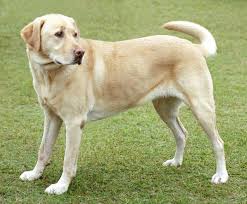Lab Husky Mix
The Lab Husky Mix, also known as the Husky Lab mix or Labrador Retriever Husky mix is a hybrid dog between the Labrador Retriever and the Siberian Husky. This mixed breed is excellent with children and makes a great family pet and companion. The Husky Lab mix is a high energy dog that is used to having specific jobs and tasks. They are a great companion and family pet. Continue reading below to see pictures, videos, and learn more about the beautiful Lab Husky Mix.
While we really recommend that you acquire all animals through a rescue, we understand that some people might go through a breeder to get their Lab Husky Mix puppy. That is, if they have any for sale. Always screen your breeders as much as possible to ensure that you are getting as high a quality dog as is possible.
If you are interested in helping animal rescues raise money, please play our quiz. Each correct answer donates to help feed shelter animals.
Here are some pictures of the Lab Husky Mix
Lab Husky Mix History
The Lab Husky Mix is a recent designer dog that has started to gain popularity in the last decade or so. I am sure this mixes have been accidentally occurring for some time and that this mix has been ending up in pounds all across the country. Being that it is not a purebred dog there is not much of a history to go off of. However, here is a brief history of both parent breeds.
The Siberian Husky is a medium size working dog breed that originated in north-eastern Siberia, Russia. The breed belongs to the Spitz genetic family and was originally bred to pull sleds over long distances rather quickly. They are known to be escape artists that will dig themselves out of the strongest fence. Being that they were bred to pull things you can imagine that they aren’t the easiest dogs to walk.
The Labrador Retriever is the most common dog breed in America for a reason. The modern Labrador's ancestors originated on the island of Newfoundland, now part of the province of Newfoundland and Labrador, Canada. The founding breed of the Labrador was the St. John's water dog, a breed that emerged through ad-hoc breedings by early settlers of the island in the 16th century. The forebears of the St. John's Dog are not known but were likely a random-bred mix of English, Irish, and Portuguese working breeds. The Newfoundland (known then as the Greater Newfoundland) is likely a result of the St. John's Dog breeding with mastiffs brought to the island by the generations of Portuguese fishermen who had been fishing offshore since the 16th century. The smaller short-coated St. John's Dog (also known then as the Lesser Newfoundland) was used for retrieval and pulling in nets from the water. These smaller dogs were the forebears of the Labrador Retriever.
Awesome videos of Lab Husky Mix puppies
Lab Husky Mix Size and Weight
LAB
Height: 22 - 24 inches at the shoulder
Weight: 55 - 80 lb.
Lifespan: 12-15 years
HUSKY
Height: 20 - 23 inches at the shoulder
Weight: 35 - 60 lb.
Lifespan: 12-15 years
Lab Husky Mix Personality
The Husky Lab mix is a very energetic, friendly, and happy dog. They aim to please, enjoy being around people and are just pleasant dogs to have in your company. They will get along well with children and other pets and should make a good addition to the family. They should also make good watchdogs in that they will bark and alert you that something is going on that shouldn’t be.
Lab Husky Mix Health
All dogs have the potential to develop genetic health problems as all breeds are susceptible to some things more than others. However, the one positive thing about getting a puppy is that you can avoid this as much as possible. A breeder should absolutely offer a health guarantee on puppies. If they won’t do this, then look no more and don’t consider that breeder at all. A reputable breeder will be honest and open about health problems in the breed and the incidence with which they occur. Health clearances prove that a dog has been tested for and cleared of a particular condition.
The Husky mixed with Labrador Retriever might be prone to eye and skin diseases, degenerative myelopathy, arthritis, hip dysplasia, and cancer.
Do not purchase a puppy from a breeder who cannot provide you with written documentation that the parents were cleared of health problems that affect the breed. A careful breeder and one who truly cares about the breed itself, screens their breeding dogs for genetic disease and breed only the healthiest and best-looking specimens. One of the most common health problems with dogs is obesity. Keeping this under control is your responsibility.
Lab Husky Mix Care
The Husky Lab mix is going to need a lot of exercise. I hope that you like to walk, walk, and walk some more. This is going to be a good dog for those who like to hike and preferably have access to clean water where they can let their dogs swim. They are going to be an easy dog to train but are also going to need to have the energy drained from them. They might have short or long hair, it kind of depends on which of the parent breeds they take after. Either way, they are more than likely going to shed a lot. So get ready to brush them often and have a good vacuum handy to clean up their hair. Give them baths as needed, but not so much that you dry out their skin. Never tie your dog up outside - that is inhumane and not fair to him. The Lab Husky mix can be a great escape artist so if left in the backyard (temporarily of course,) they will be tough to keep in. You will need to make sure the fence is extremely secure and buried a couple of feet in the ground. Plan on taking them for extremely long walks and hikes to keep their energy level down.
Lab Husky Mix Feeding
A lot of times diet is done on a per-dog basis. Each one is unique and has different dietary requirements. Most dogs in the U.S. are overweight. A mix like this one that is prone to hip and elbow dysplasia should really be on fish oil and glucosamine and chondroitin supplements as soon as possible.
Overfeeding any dog is not a good idea as that can really exacerbate health problems such as elbow and hip dysplasia.
A good diet to look into is Raw Food Diet. A raw food diet will be especially good for the Wolf background.



